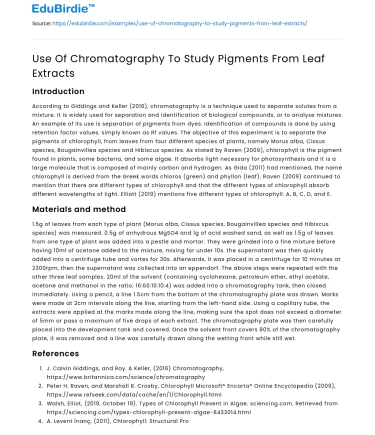Introduction
According to Giddings and Keller (2016), chromatography is a technique used to separate solutes from a mixture. It is widely used for separation and identification of biological compounds, or to analyse mixtures. An example of its use is separation of pigments from dyes. Identification of compounds is done by using retention factor values, simply known as Rf values. The objective of this experiment is to separate the pigments of chlorophyll, from leaves from four different species of plants, namely Morus alba, Cissus species, Bougainvillea species and Hibiscus species. As stated by Raven (2009), chlorophyll is the pigment found in plants, some bacteria, and some algae. It absorbs light necessary for photosynthesis and it is a large molecule that is composed of mainly carbon and hydrogen. As Gida (2011) had mentioned, the name chlorophyll is derived from the Greek words chloros (green) and phyllon (leaf). Raven (2009) continued to mention that there are different types of chlorophyll and that the different types of chlorophyll absorb different wavelengths of light. Elliott (2019) mentions five different types of chlorophyll: A, B, C, D, and E.
Materials and method
1.5g of leaves from each type of plant (Morus alba, Cissus species, Bougainvillea species and Hibiscus species) was measured. 0.5g of anhydrous MgSO4 and 1g of acid washed sand, as well as 1.5g of leaves from one type of plant was added into a pestle and mortar. They were grinded into a fine mixture before having 10ml of acetone added to the mixture, mixing for under 10s. the supernatant was then quickly added into a centrifuge tube and vortex for 30s. Afterwards, it was placed in a centrifuge for 10 minutes at 2300rpm, then the supernatant was collected into an eppendorf. The above steps were repeated with the other three leaf samples. 20ml of the solvent (containing cyclohexane, petroleum ether, ethyl acetate, acetone and methanol in the ratio; 16:60:10:10:4) was added into a chromatography tank, then closed immediately. Using a pencil, a line 1.5cm from the bottom of the chromatography plate was drawn. Marks were made at 2cm intervals along the line, starting from the left-hand side. Using a capillary tube, the extracts were applied at the marks made along the line, making sure the spot does not exceed a diameter of 5mm or pass a maximum of five drops of each extract. The chromatography plate was then carefully placed into the development tank and covered. Once the solvent front covers 80% of the chromatography plate, it was removed and a line was carefully drawn along the wetting front while still wet.
Save your time!
We can take care of your essay
- Proper editing and formatting
- Free revision, title page, and bibliography
- Flexible prices and money-back guarantee
References
- J. Calvin Giddings, and Roy. A Keller, (2016) Chromatography, https://www.britannica.com/science/chromatography
- Peter H. Raven, and Marshall R. Crosby, Chlorophyll Microsoft® Encarta® Online Encyclopedia (2009), https://www.refseek.com/data/cache/en/1/Chlorophyll.html
- Walsh, Elliot, (2019, October 19). Types of Chlorophyll Present in Algae. sciencing.com. Retrieved from https://sciencing.com/types-chlorophyll-present-algae-8433014.html
- A. Levent İnanç, (2011), Chlorophyll: Structural Properties, Health Benefits and Its Occurrence in Virgin Olive Oils, http://www.academicfoodjournal.com/archive/2011/issue2/26-32.pdf
Did you like this example?
Make sure you submit a unique essay
Our writers will provide you with an essay sample written from scratch: any topic, any deadline, any instructions.
Cite this paper
-
APA
-
MLA
-
Harvard
-
Vancouver
Use Of Chromatography To Study Pigments From Leaf Extracts.
(2022, February 17). Edubirdie. Retrieved March 3, 2025, from https://hub.edubirdie.com/examples/use-of-chromatography-to-study-pigments-from-leaf-extracts/
“Use Of Chromatography To Study Pigments From Leaf Extracts.” Edubirdie, 17 Feb. 2022, hub.edubirdie.com/examples/use-of-chromatography-to-study-pigments-from-leaf-extracts/
Use Of Chromatography To Study Pigments From Leaf Extracts. [online].
Available at: <https://hub.edubirdie.com/examples/use-of-chromatography-to-study-pigments-from-leaf-extracts/> [Accessed 3 Mar. 2025].
Use Of Chromatography To Study Pigments From Leaf Extracts [Internet]. Edubirdie.
2022 Feb 17 [cited 2025 Mar 3].
Available from: https://hub.edubirdie.com/examples/use-of-chromatography-to-study-pigments-from-leaf-extracts/
copy






 Stuck on your essay?
Stuck on your essay?

